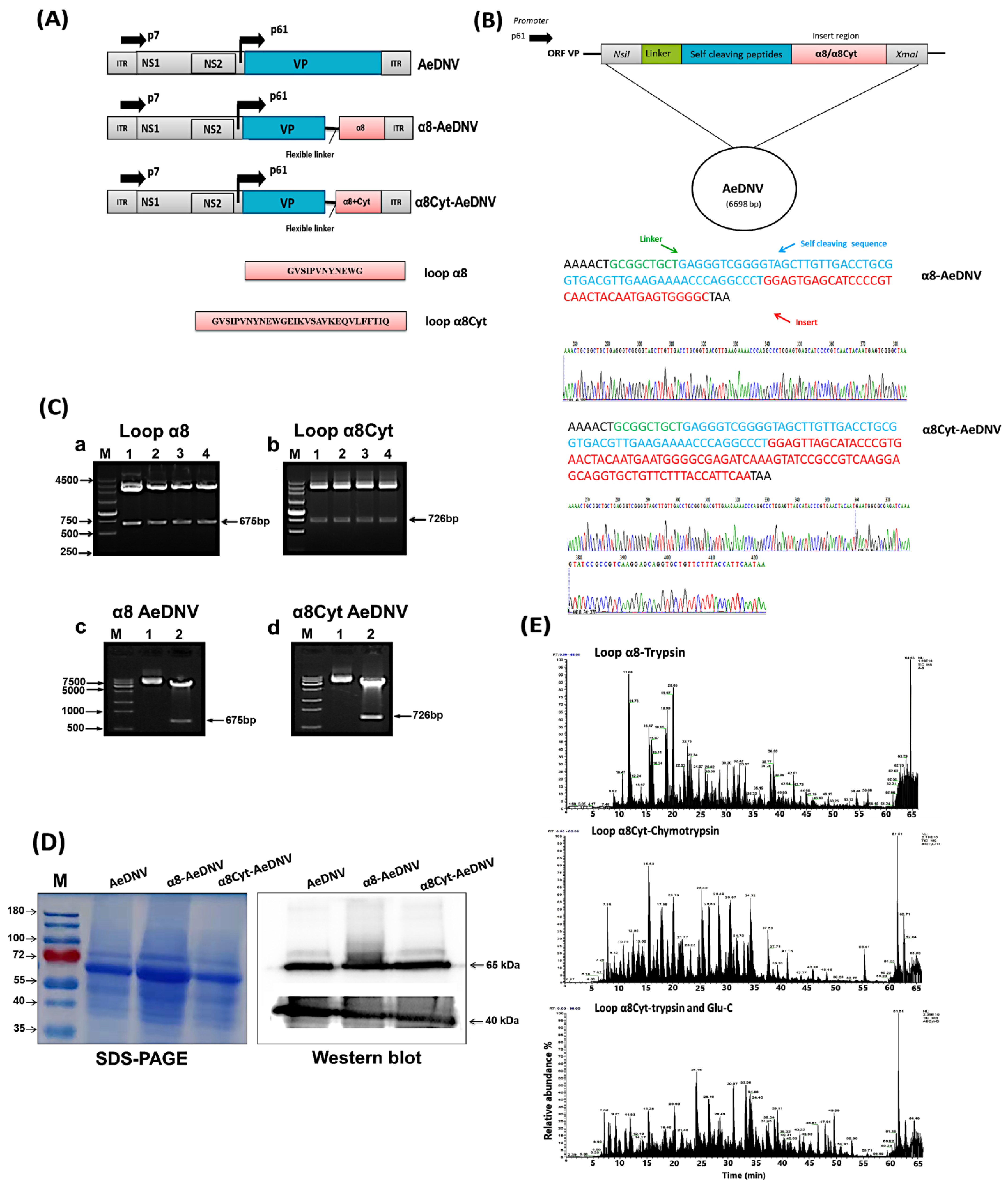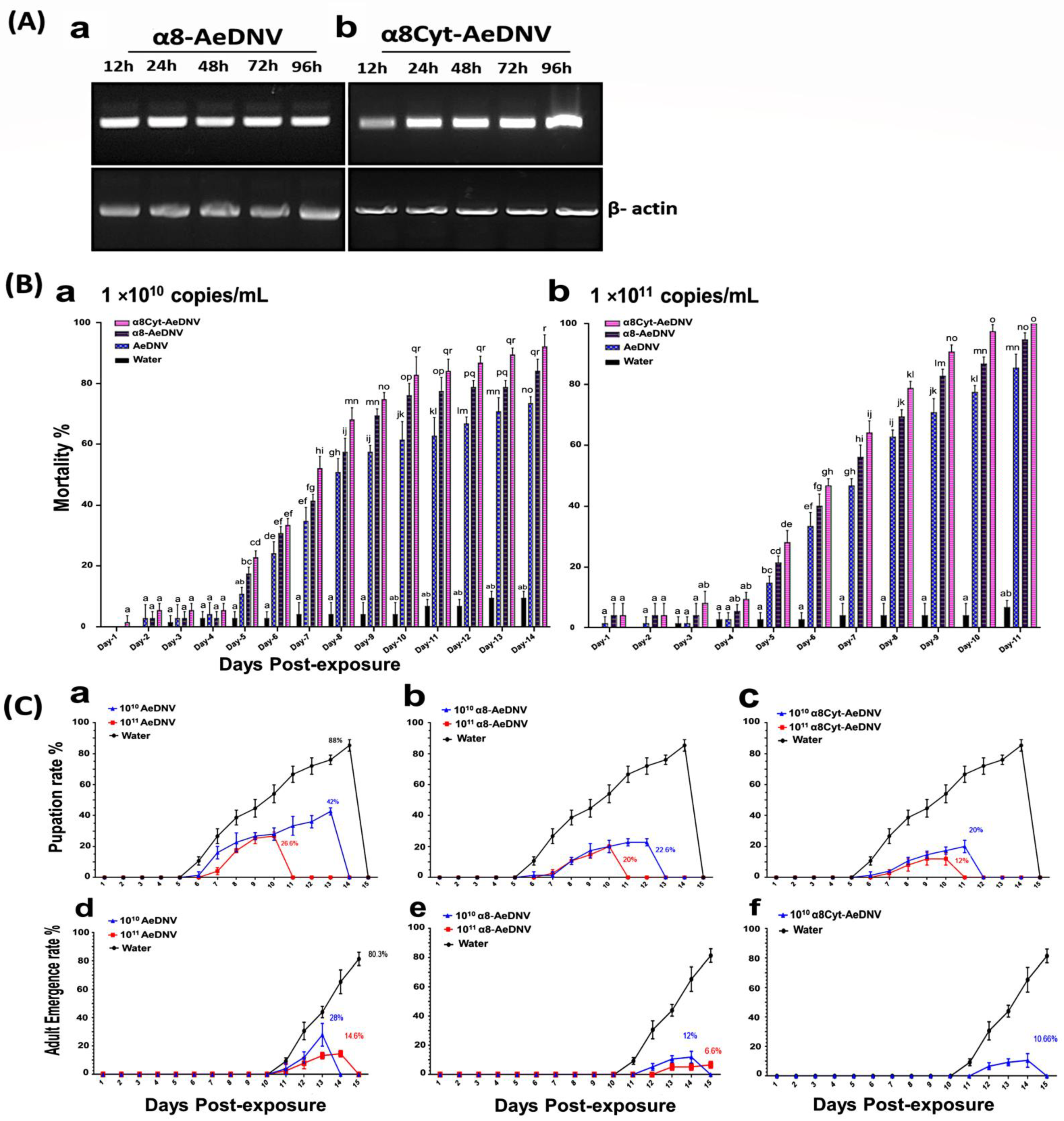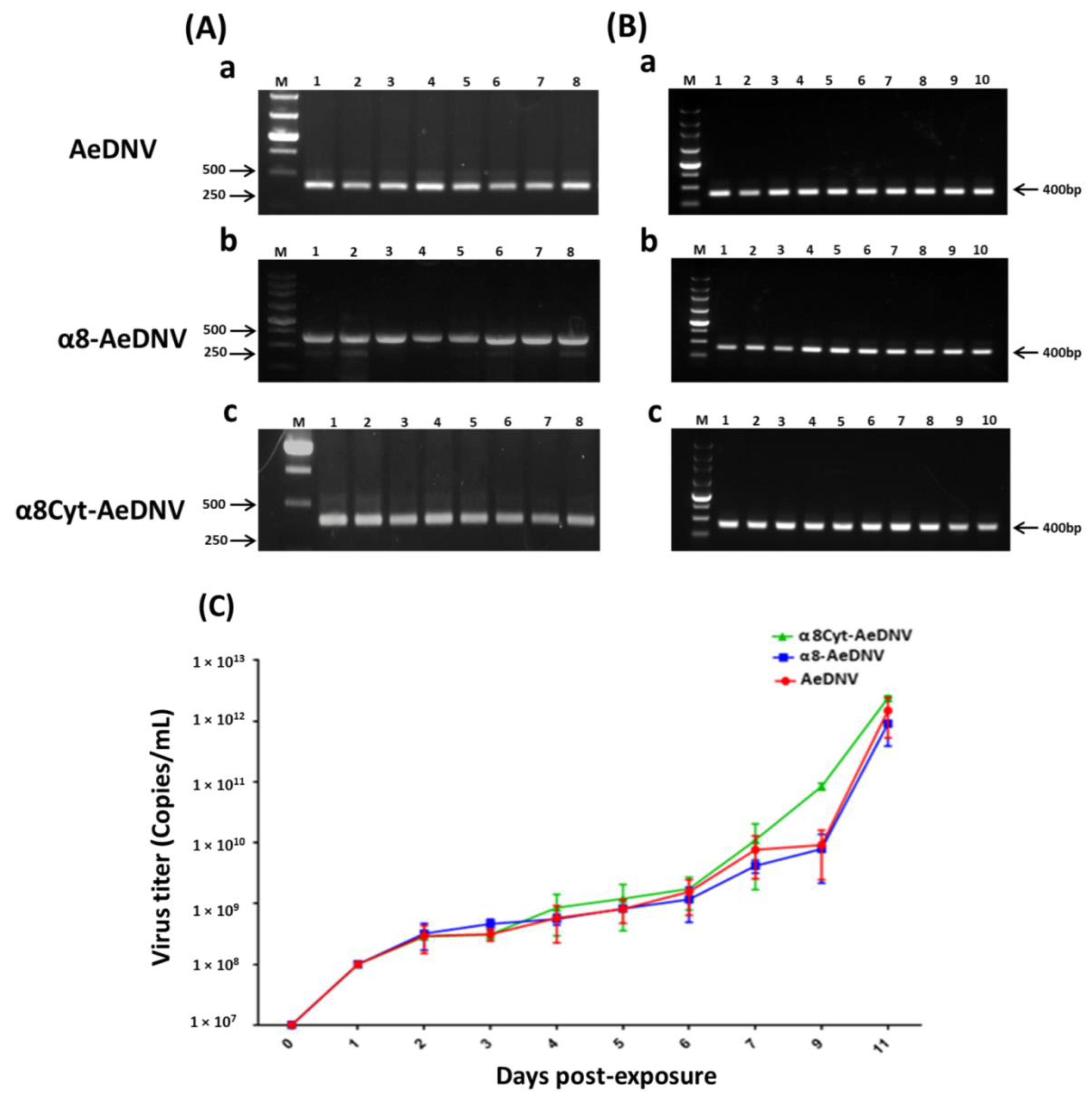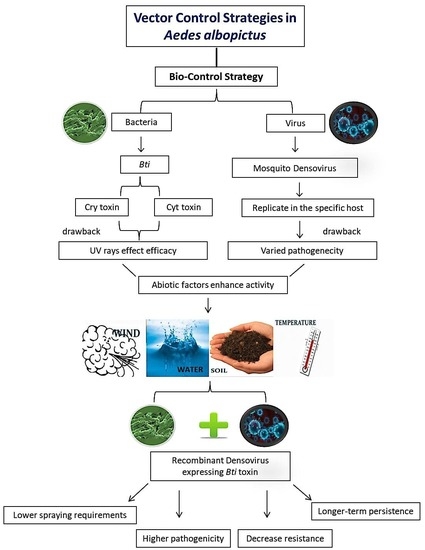Recombinant Mosquito Densovirus with Bti Toxins Significantly Improves Pathogenicity against Aedes albopictus
Abstract
:1. Introduction
2. Results
2.1. Expression, Cloning, and Identification of Bti Toxins in AeDNV
2.2. Efficiency of Recombinant Virus in C6/36 Cell Lines and Insecticidal Efficacy against Ae. albopictus
2.3. Stability of the Recombinant Viruses
3. Discussion
4. Materials and Methods
4.1. Mosquito Maintenance
4.2. Construction of Recombinant Plasmids
4.3. Cell line Transfection
4.4. Production of Recombinant Virus
4.5. Western Blotting and Nano LC-MS/MS Analysis
4.6. Toxicity Bioassay
4.7. Determination of Genetic Stability of the Virus
4.8. Statistical Analysis
Supplementary Materials
Author Contributions
Funding
Data Availability Statement
Conflicts of Interest
References
- Cheng, G.; Liu, Y.; Wang, P.; Xiao, X. Mosquito defense strategies against viral infection. Trends Parasitol. 2016, 32, 177–186. [Google Scholar] [CrossRef] [PubMed] [Green Version]
- Wang, G.-H.; Gamez, S.; Raban, R.R.; Marshall, J.M.; Alphey, L.; Li, M.; Rasgon, J.L.; Akbari, O.S. Combating mosquito-borne diseases using genetic control technologies. Nat. Commun. 2021, 12, 1–12. [Google Scholar] [CrossRef] [PubMed]
- Ligsay, A.; Telle, O.; Paul, R. Challenges to Mitigating the Urban Health Burden of Mosquito-Borne Diseases in the Face of Climate Change. Int. J. Environ. Res. Public Health 2021, 18, 5035. [Google Scholar] [CrossRef] [PubMed]
- Metzger, M.E. A legacy of mosquito control through wetland management: A tribute to William E. Walton and his contributions to science and entomology. Wetl. Ecol. Manag. 2021, 1, 1–21. [Google Scholar] [CrossRef]
- Docile, T.; Figueiró, R.; Molina, O.; Gil-Azevedo, L.; Nessimian, J. Effects of Bacillus thuringiensis var. israelensis on the Black Fly Communities (Diptera, Simuliidae) in Tropical Streams. Neotrop. Entomol. 2021, 50, 269–281. [Google Scholar] [CrossRef] [PubMed]
- Carlson, J.; Suchman, E.; Buchatsky, L. Densoviruses for control and genetic manipulation of mosquitoes. Adv. Virus Res. 2006, 68, 361–392. [Google Scholar]
- Johnson, R.M.; Rasgon, J.L. Densonucleosis viruses (‘densoviruses’) for mosquito and pathogen control. Curr. Opin. Insect Sci. 2018, 28, 90–97. [Google Scholar] [CrossRef]
- Lebedeva, O.; Zelenko, A.; Kuznetsova, M. The detection of viral infection in larvae of Aedes aegypti. Mikrobiol. J. 1972, 34, 70–73. [Google Scholar]
- Zhai, Y.-g.; Lv, X.-j.; Sun, X.-h.; Fu, S.-h.; Fen, Y.; Tong, S.-x.; Wang, Z.-x.; Tang, Q.; Attoui, H.; Liang, G.-d. Isolation and characterization of the full coding sequence of a novel densovirus from the mosquito Culex pipiens pallens. J. General. Virol. 2008, 89, 195–199. [Google Scholar] [CrossRef]
- Li, J.; Dong, Y.; Sun, Y.; Lai, Z.; Zhao, Y.; Liu, P.; Gao, Y.; Chen, X.; Gu, J. A novel densovirus isolated from the asian tiger mosquito displays varied pathogenicity depending on its host species. Front. Microbiol. 2019, 10, 1549. [Google Scholar] [CrossRef]
- Liu, L.; Shen, Q.; Li, N.; He, Y.; Han, N.; Wang, X.; Meng, J.; Peng, Y.; Pan, M.; Jin, Y.; et al. Comparative viromes of Culicoides and mosquitoes reveal their consistency and diversity in viral profiles. Brief. Bioinfor. 2020, 22, bbaa323. [Google Scholar] [CrossRef] [PubMed]
- Johnson, R. Anopheles Gambiae Densovirus as a Viral Vector for the Expression of Small RNAs and Transgenes. Available online: https://etda.libraries.psu.edu/catalog/18678ruj130 (accessed on 20 November 2021).
- Parry, R.; James, M.E.; Asgari, S. Uncovering the Worldwide Diversity and Evolution of the Virome of the Mosquitoes Aedes aegypti and Aedes albopictus. Microorganisms 2021, 9, 1653. [Google Scholar] [CrossRef] [PubMed]
- Gu, J.-B.; Dong, Y.-Q.; Peng, H.-J.; Chen, X.-G. A recombinant AeDNA containing the insect-specific toxin, BmK IT1, displayed an increasing pathogenicity on Aedes albopictus. Am. J. Trop. Med. Hyg. 2010, 83, 614. [Google Scholar] [CrossRef] [PubMed] [Green Version]
- Perrin, A.; Gosselin-Grenet, A.-S.; Rossignol, M.; Ginibre, C.; Scheid, B.; Lagneau, C.; Chandre, F.; Baldet, T.; Ogliastro, M.; Bouyer, J. Mosquito densoviruses: The revival of a biological control agent against urban Aedes vectors of arboviruses. bioRxiv 2020, 1, 055830. [Google Scholar]
- Perrin, A.; Gosselin-Grenet, A.-S.; Rossignol, M.; Ginibre, C.; Scheid, B.; Lagneau, C.; Chandre, F.; Baldet, T.; Ogliastro, M.; Bouyer, J. Variation in the susceptibility of urban Aedes mosquitoes infected with a densovirus. Sci. Rep. 2020, 10, 1–10. [Google Scholar] [CrossRef]
- Buchatsky, L. Densonucleosis of bloodsucking mosquitoes. Dis. Aquat. Org. 1989, 6, 145–150. [Google Scholar] [CrossRef]
- Hirunkanokpun, S.; Carlson, J.O.; Kittayapong, P. Evaluation of mosquito densoviruses for controlling Aedes aegypti (Diptera: Culicidae): Variation in efficiency due to virus strain and geographic origin of mosquitoes. Am. J. Trop. Med. Hyg. 2008, 78, 784–790. [Google Scholar] [CrossRef] [Green Version]
- Wilke, A.B.B.; Marrelli, M.T. Genetic control of mosquitoes: Population suppression strategies. Rev. Instit. Med. Trop. Sao Paulo 2012, 54, 287–292. [Google Scholar] [CrossRef]
- Upadhyay, A.; Hadiya, J.; Gharde, S. Biocontrol: An effective tool for agricultural insect pests management. J. Pharm. Innov. 2021, 10, 284–288. [Google Scholar] [CrossRef]
- de Castro Poncio, L.; Dos Anjos, F.A.; de Oliveira, D.A.; Rebechi, D.; de Oliveira, R.N.; Chitolina, R.F.; Fermino, M.L.; Bernardes, L.G.; Guimarães, D.; Lemos, P.A.; et al. Novel sterile insect technology program results in suppression of a field mosquito population and subsequently to reduced incidence of dengue. J. Infect. Dis. 2021, 224, 1005–1014. [Google Scholar] [CrossRef]
- Bliman, P.-A. A feedback control perspective on biological control of dengue vectors by Wolbachia infection. Eur. J. Control 2021, 59, 188–206. [Google Scholar] [CrossRef]
- Mysore, K.; Sun, L.; Hapairai, L.K.; Wang, C.-W.; Roethele, J.B.; Igiede, J.; Scheel, M.P.; Scheel, N.D.; Li, P.; Wei, N. A Broad-Based Mosquito Yeast Interfering RNA Pesticide Targeting Rbfox1 Represses Notch Signaling and Kills Both Larvae and Adult Mosquitoes. Pathogens 2021, 10, 1251. [Google Scholar] [CrossRef] [PubMed]
- Khalil, S.; Munawar, K.; Alahmed, A.M.; Mohammed, A. RNAi-Mediated Screening of Selected Target Genes against Culex quinquefasciatus (Diptera: Culicidae). J. Med. Entomol. 2021, 58, 2177–2185. [Google Scholar] [CrossRef] [PubMed]
- Whitten, M.M. Novel RNAi delivery systems in the control of medical and veterinary pests. Curr. Opin. Insect Sci. 2019, 34, 1–6. [Google Scholar] [CrossRef] [PubMed]
- Dong, S.; Dong, Y.; Simões, M.L.; Dimopoulos, G. Mosquito transgenesis for malaria control. Trends Parasitol. 2021, 38, 54–66. [Google Scholar] [CrossRef]
- Liu, P.; Li, X.; Gu, J.; Dong, Y.; Liu, Y.; Santhosh, P.; Chen, X. Development of non-defective recombinant densovirus vectors for microRNA delivery in the invasive vector mosquito, Aedes albopictus. Sci. Rep. 2016, 6, 1–13. [Google Scholar] [CrossRef] [Green Version]
- Xu, T.-L.; Sun, Y.-W.; Feng, X.-Y.; Zhou, X.-N.; Zheng, B. Development of miRNA-Based Approaches to Explore the Interruption of Mosquito-Borne Disease Transmission. Front. Cell. Infect. Microbiol. 2021, 11, 546. [Google Scholar] [CrossRef]
- Brühl, C.A.; Després, L.; Frör, O.; Patil, C.D.; Poulin, B.; Tetreau, G.; Allgeier, S. Environmental and socioeconomic effects of mosquito control in Europe using the biocide Bacillus thuringiensis subsp. israelensis (Bti). Sci. Total Environ. 2020, 724, 137800. [Google Scholar] [CrossRef]
- Silva-Filha, M.; Romão, T.P.; Rezende, T.M.T.; Carvalho, K.D.S.; Gouveia de Menezes, H.S.; Alexandre do Nascimento, N. Bacterial Toxins Active against Mosquitoes: Mode of Action and Resistance. Toxins 2021, 13, 523. [Google Scholar] [CrossRef]
- Pérez, C.; Fernandez, L.E.; Sun, J.; Folch, J.L.; Gill, S.S.; Soberón, M.; Bravo, A. Bacillus thuringiensis subsp. israelensis Cyt1Aa synergizes Cry11Aa toxin by functioning as a membrane-bound receptor. Proc. Natl. Acad. Sci. USA 2005, 102, 18303–18308. [Google Scholar] [CrossRef] [Green Version]
- Pardo-Lopez, L.; Soberon, M.; Bravo, A. Bacillus thuringiensis insecticidal three-domain Cry toxins: Mode of action, insect resistance and consequences for crop protection. FEMS Microbiol. Rev. 2013, 37, 3–22. [Google Scholar] [CrossRef] [PubMed] [Green Version]
- Soberón, M.; López-Díaz, J.A.; Bravo, A. Cyt toxins produced by Bacillus thuringiensis: A protein fold conserved in several pathogenic microorganisms. Peptides 2013, 41, 87–93. [Google Scholar] [CrossRef] [PubMed]
- Das, S.K.; Pradhan, S.K.; Samal, K.C.; Singh, N.R. Structural, functional, and evolutionary analysis of Cry toxins of Bacillus thuringiensis: An in silico study. Egypt. J. Biol. Pest Control 2021, 31, 44. [Google Scholar] [CrossRef]
- Cantón, P.E.; Reyes, E.Z.; De Escudero, I.R.; Bravo, A.; Soberón, M. Binding of Bacillus thuringiensis subsp. israelensis Cry4Ba to Cyt1Aa has an important role in synergism. Peptides 2011, 32, 595–600. [Google Scholar] [CrossRef] [Green Version]
- López-Molina, S.; do Nascimento, N.A.; Silva-Filha, M.H.N.L.; Guerrero, A.; Sánchez, J.; Pacheco, S.; Gill, S.S.; Soberón, M.; Bravo, A. In vivo nanoscale analysis of the dynamic synergistic interaction of Bacillus thuringiensis Cry11Aa and Cyt1Aa toxins in Aedes aegypti. PLoS Pathog. 2021, 17, e1009199. [Google Scholar] [CrossRef]
- Nascimento, N.A.; Torres-Quintero, M.C.; Molina, S.L.; Pacheco, S.; Romão, T.P.; Pereira-Neves, A.; Soberón, M.; Bravo, A.; Silva-Filha, M.H.N.L. Functional Bacillus thuringiensis Cyt1Aa is necessary to synergize Lysinibacillus sphaericus binary toxin (Bin) against Bin-resistant and-refractory mosquito species. Appl. Environ. Microbiol. 2020, 86, e02770-19. [Google Scholar] [CrossRef]
- Wirth, M.C.; Walton, W.E.; Federici, B.A. Evolution of resistance in Culex quinquefasciatus (Say) selected with a recombinant Bacillus thuringiensis strain-producing Cyt1Aa and Cry11Ba, and the binary toxin, Bin, from Lysinibacillus sphaericus. Appl. Environ. Microbiol. 2015, 52, 1028–1035. [Google Scholar]
- Valtierra-de-Luis, D.; Villanueva, M.; Lai, L.; Williams, T.; Caballero, P. Potential of Cry10Aa and Cyt2Ba, Two Minority δ-endotoxins Produced by Bacillus thuringiensis ser. israelensis, for the Control of Aedes aegypti Larvae. Toxins 2020, 12, 355. [Google Scholar] [CrossRef]
- Monnerat, R.; Pereira, E.; Teles, B.; Martins, E.; Praça, L.; Queiroz, P.; Soberon, M.; Bravo, A.; Ramos, F.; Soares, C.M. Synergistic activity of Bacillus thuringiensis toxins against Simulium spp. larvae. J. Invertebr. Pathol. 2014, 121, 70–73. [Google Scholar] [CrossRef]
- Rao, P.; Goswami, D.; Rawal, R. Cry toxins of Bacillus thuringiensis: A glimpse into the Pandora’s box for the strategic control of vector borne diseases. Environ. Sustain. 2021, 4, 1–15. [Google Scholar] [CrossRef]
- Yang, J.; Quan, Y.; Sivaprasath, P.; Shabbir, M.Z.; Wang, Z.; Ferré, J.; He, K. Insecticidal activity and synergistic combinations of ten different Bt toxins against Mythimna separata (Walker). Toxins 2018, 10, 454. [Google Scholar] [CrossRef] [PubMed] [Green Version]
- Chattopadhyay, P.; Banerjee, G. Recent advancement on chemical arsenal of Bt toxin and its application in pest management system in agricultural field. 3 Biotech 2018, 8, 1–12. [Google Scholar] [CrossRef] [PubMed]
- Torres-Quintero, M.-C.; Gómez, I.; Pacheco, S.; Sánchez, J.; Flores, H.; Osuna, J.; Mendoza, G.; Soberón, M.; Bravo, A. Engineering Bacillus thuringiensis Cyt1Aa toxin specificity from dipteran to lepidopteran toxicity. Sci. Rep. 2018, 8, 4989. [Google Scholar] [CrossRef] [PubMed]
- Kamatham, S.; Munagapati, S.; Manikanta, K.N.; Vulchi, R.; Chadipiralla, K.; Indla, S.H.; Allam, U.S. Recent advances in engineering crop plants for resistance to insect pests. Egypt. J. Biol. Pest Control 2021, 31, 120. [Google Scholar] [CrossRef]
- Liu, L.; Li, Z.; Luo, X.; Zhang, X.; Chou, S.-H.; Wang, J.; He, J. Which Is Stronger? A Continuing Battle between Cry Toxins and Insects. Front. Microbiol. 2021, 12, 665101. [Google Scholar] [CrossRef]
- Valtierra-de-Luis, D.; Villanueva, M.; Berry, C.; Caballero, P. Potential for Bacillus thuringiensis and Other Bacterial Toxins as Biological Control Agents to Combat Dipteran Pests of Medical and Agronomic Importance. Toxins 2020, 12, 773. [Google Scholar] [CrossRef]
- Fernández, L.E.; Pérez, C.; Segovia, L.; Rodríguez, M.H.; Gill, S.S.; Bravo, A.; Soberón, M. Cry11Aa toxin from Bacillus thuringiensis binds its receptor in Aedes aegypti mosquito larvae through loop α-8 of domain II. FEBS Lett. 2005, 579, 3508–3514. [Google Scholar] [CrossRef] [Green Version]
- Chen, J.; Aimanova, K.G.; Fernandez, L.E.; Bravo, A.; Soberon, M.; Gill, S.S. Aedes aegypti cadherin serves as a putative receptor of the Cry11Aa toxin from Bacillus thuringiensis subsp. israelensis. Biochem. J. 2009, 424, 191–200. [Google Scholar] [CrossRef] [Green Version]
- Fernandez, L.E.; Martinez-Anaya, C.; Lira, E.; Chen, J.; Evans, A.; Hernández-Martínez, S.; Lanz-Mendoza, H.; Bravo, A.; Gill, S.S.; Soberón, M. Cloning and epitope mapping of Cry11Aa-binding sites in the Cry11Aa-receptor alkaline phosphatase from Aedes aegypti. Biochemistry 2009, 48, 8899–8907. [Google Scholar] [CrossRef] [Green Version]
- El-Far, M.; Li, Y.; Fédière, G.; Abol-Ela, S.; Tijssen, P. Lack of infection of vertebrate cells by the densovirus from the maize worm Mythimna loreyi (MlDNV). Virus Res. 2004, 99, 17–24. [Google Scholar] [CrossRef]
- Empey, M.A.; Lefebvre-Raine, M.; Gutierrez-Villagomez, J.M.; Langlois, V.S.; Trudeau, V.L. A Review of the Effects of the Biopesticides Bacillus thuringiensis Serotypes israelensis (Bti) and kurstaki (Btk) in Amphibians. Arch. Environ. Contam. Toxicol. 2021, 80, 1–12. [Google Scholar] [CrossRef] [PubMed]
- Schweizer, M.; Miksch, L.; Köhler, H.R.; Triebskorn, R. Does Bti (Bacillus thuringiensis var. israelensis) affect Rana temporaria tadpoles? Ecotoxicol. Environ. Saf. 2019, 181, 121–129. [Google Scholar] [CrossRef] [PubMed]
- Yamagiwa, M.; Sakagawa, K.; Sakai, H. Functional analysis of two processed fragments of Bacillus thuringiensis Cry11A toxin. Biosci. Biotechnol. Biochem. 2004, 68, 523–528. [Google Scholar] [CrossRef] [Green Version]
- van Frankenhuyzen, K. Cross-order and cross-phylum activity of Bacillus thuringiensis pesticidal proteins. J. Invertebr. Pathol. 2013, 114, 76–85. [Google Scholar] [CrossRef] [PubMed]
- Federici, B.A.; Bauer, L.S. Cyt1Aa protein of Bacillus thuringiensis is toxic to the cottonwood leaf beetle, Chrysomela scripta, and suppresses high levels of resistance to Cry3Aa. Appl. Environ. Microbiol. 1998, 64, 4368–4371. [Google Scholar] [CrossRef] [Green Version]
- Van Frankenhuyzen, K.; Tonon, A. Activity of Bacillus thuringiensis cyt1Ba crystal protein against hymenopteran forest pests. J. Invertebr. Pathol. 2013, 113, 160–162. [Google Scholar] [CrossRef]
- Rajamohan, F.; Alzate, O.; Cotrill, J.A.; Curtiss, A.; Dean, D.H. Protein engineering of Bacillus thuringiensis δ-endotoxin: Mutations at domain II of CryIAb enhance receptor affinity and toxicity toward gypsy moth larvae. Proc. Natl. Acad. Sci. USA 1996, 93, 14338–14343. [Google Scholar] [CrossRef] [Green Version]
- Lee, M.K.; Jenkins, J.L.; You, T.H.; Curtiss, A.; Son, J.J.; Adang, M.J.; Dean, D.H. Mutations at the arginine residues in α8 loop of Bacillus thuringiensis δ-endotoxin Cry1Ac affect toxicity and binding to Manduca sexta and Lymantria dispar aminopeptidase N. FEBS Lett. 2001, 497, 108–112. [Google Scholar] [CrossRef] [Green Version]
- Rajamohan, F.; Hussain, S.-R.A.; Cotrill, J.A.; Gould, F.; Dean, D.H. Mutations at domain II, loop 3, of Bacillus thuringiensis CryIAa and CryIAb δ-endotoxins suggest loop 3 is involved in initial binding to lepidopteran midguts. J. Biol. Chem. 1996, 271, 25220–25226. [Google Scholar] [CrossRef] [Green Version]
- Blaney, J.E.; Durbin, A.P.; Murphy, B.R.; Whitehead, S.S. Development of a live attenuated dengue virus vaccine using reverse genetics. Viral Immunol. 2006, 19, 10–32. [Google Scholar] [CrossRef]
- Ruggli, N.; Rice, C.M. Functional cDNA clones of the Flaviviridae: Strategies and applications. Adv. Virus Res. 1999, 53, 183–207. [Google Scholar] [PubMed]
- Choi, V.W.; Asokan, A.; Haberman, R.A.; Samulski, R.J. Production of recombinant adeno-associated viral vectors for in vitro and in vivo use. Curr. Protoc. Molec. Biol. 2007, 78, 16–25. [Google Scholar] [CrossRef] [PubMed]
- Hirsch, M. Adeno-associated virus inverted terminal repeats stimulate gene editing. Gene Ther. 2015, 22, 190–195. [Google Scholar] [CrossRef] [Green Version]
- Sun, Y.; Dong, Y.; Li, J.; Lai, Z.; Hao, Y.; Liu, P.; Chen, X.; Gu, J. Development of large-scale mosquito densovirus production by in vivo methods. Parasites Vectors 2019, 12, 255. [Google Scholar] [CrossRef] [PubMed]
- Kittayapong, P.; Baisley, K.J.; O′Neill, S.L. A mosquito densovirus infecting Aedes aegypti and Aedes albopictus from Thailand. Am. J. Trop. Med. Hyg. 2001, 61, 2–7. [Google Scholar] [CrossRef] [PubMed] [Green Version]
- Ledermann, J.P.; Suchman, E.L.; Black, W.C., IV; Carlson, J.O. Infection and Pathogenicity of the Mosquito Densoviruses AeDNV, HeDNV, and APeDNV in Aedes aegypti Mosquitoes (Diptera: Culicidae). J. Econ. Entomol. 2004, 97, 1828–1835. [Google Scholar] [CrossRef] [PubMed]
- Shao, E.; Lin, L.; Chen, C.; Chen, H.; Zhuang, H.; Wu, S.; Sha, L.; Guan, X.; Huang, Z. Loop replacements with gut-binding peptides in Cry1Ab domain II enhanced toxicity against the brown planthopper. Nilaparvata lugens (Stål). Sci. Rep. 2016, 6, 1–9. [Google Scholar]
- Wang, S.; Ghosh, A.K.; Bongio, N.; Stebbings, K.A.; Lampe, D.J.; Jacobs-Lorena, M. Fighting malaria with engineered symbiotic bacteria from vector mosquitoes. Proc. Natl. Acad. Sci. USA 2012, 109, 12734–12739. [Google Scholar] [CrossRef] [Green Version]



| Sample | LC50 (Copies/mL) | LT50 (Days) | ||||
|---|---|---|---|---|---|---|
| Copies/mL | 95% CI | 1 × 1010 Copies/mL, 95% CI | 1 × 1011 Copies/mL, 95% CI | |||
| AeDNV | 1010.6 | 1010.09–1011.2 | 8.7 d | (8.14–9.08) | 7.28 d | (6.55–7.98) |
| α8-AeDNV | 109.8 | 109.39–1010.5 | 7.61 d | (7.26–7.94) | 6.49 d | (5.48–7.48) |
| α8Cyt-AeDNV | 109.3 | 108.9–109.93 | 6.71 d | (5.48–7.87) | 5.85 d | (4.61–6.96) |
| Days | wt-AeDNV | α8-AeDNV | α8Cyt-AeDNV |
|---|---|---|---|
| 1 | 1 × 108 | 1 × 108 | 1 × 108 |
| 2 | 2.93 × 108 | 3.21 × 108 | 2.86 × 108 |
| 3 | 3.12 × 108 | 4.63 × 108 | 3.1 × 108 |
| 4 | 5.75 × 108 | 5.56 × 108 | 8.55 × 108 |
| 5 | 8.15 × 108 | 8.24 × 108 | 1.21 × 109 |
| 6 | 1.56 × 109 | 1.18 × 109 | 1.76 × 109 |
| 7 | 7.73 × 109 | 4.19 × 109 | 1.1 × 1010 |
| 9 | 9.24 × 109 | 7.93 × 109 | 8.42 × 1010 |
| 11 | 1.49 × 1012 | 9.14 × 1011 | 2.41 × 1012 |
| Primer Name | Sequences (5′ to 3′) | Annealing Temperature and Cycles | Product Size (bp) | Program Application |
|---|---|---|---|---|
| Loop α8 F | TTAGCCCCACTCATTGTAGTTGAC | 55 °C, 35 | 255 bp | RT-PCR |
| Loop α8 R | CGAATGAGTACAAAACTACACCTC | |||
| Loop α8Cyt F | TTGACGGCGGATACTTTGAT | 275 bp | ||
| Loop α8Cyt R | CGAATGAGTACAAAACTACACCTC | |||
| β-Actin F | CACCAGGGTGTGATGGTCGG | 911 bp | ||
| β-Actin R | CCACCGATCCAGACGGAGT |
| Primer Name | Sequences (5′ to 3′) | Annealing Temperature and Cycles | Program Application |
|---|---|---|---|
| AeDNV-qF | AACCGATAGAACGAACAC | 55 °C, 40 | Virus quantification |
| AeDNV-qR | TTGGAGGACGACTGATTA | ||
| pMDV-F | AACTACCAGGAGCAGGAT | 55 °C, 30 | PCR-based viral genome detection |
| pMDV-R | TGTATGTGCGTTGTCTTC |
Publisher’s Note: MDPI stays neutral with regard to jurisdictional claims in published maps and institutional affiliations. |
© 2022 by the authors. Licensee MDPI, Basel, Switzerland. This article is an open access article distributed under the terms and conditions of the Creative Commons Attribution (CC BY) license (https://creativecommons.org/licenses/by/4.0/).
Share and Cite
Batool, K.; Alam, I.; Liu, P.; Shu, Z.; Zhao, S.; Yang, W.; Jie, X.; Gu, J.; Chen, X.-G. Recombinant Mosquito Densovirus with Bti Toxins Significantly Improves Pathogenicity against Aedes albopictus. Toxins 2022, 14, 147. https://doi.org/10.3390/toxins14020147
Batool K, Alam I, Liu P, Shu Z, Zhao S, Yang W, Jie X, Gu J, Chen X-G. Recombinant Mosquito Densovirus with Bti Toxins Significantly Improves Pathogenicity against Aedes albopictus. Toxins. 2022; 14(2):147. https://doi.org/10.3390/toxins14020147
Chicago/Turabian StyleBatool, Khadija, Intikhab Alam, Peiwen Liu, Zeng Shu, Siyu Zhao, Wenqiang Yang, Xiao Jie, Jinbao Gu, and Xiao-Guang Chen. 2022. "Recombinant Mosquito Densovirus with Bti Toxins Significantly Improves Pathogenicity against Aedes albopictus" Toxins 14, no. 2: 147. https://doi.org/10.3390/toxins14020147
APA StyleBatool, K., Alam, I., Liu, P., Shu, Z., Zhao, S., Yang, W., Jie, X., Gu, J., & Chen, X.-G. (2022). Recombinant Mosquito Densovirus with Bti Toxins Significantly Improves Pathogenicity against Aedes albopictus. Toxins, 14(2), 147. https://doi.org/10.3390/toxins14020147





